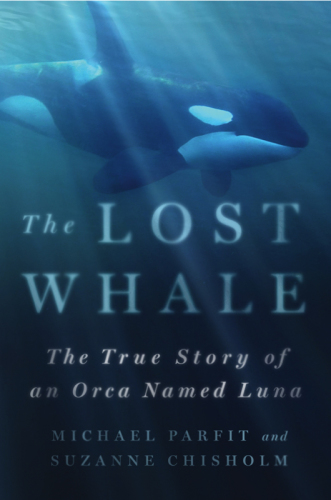
The Lost Whale
The True Story of an Orca Named Luna
- اطلاعات
- نقد و بررسی
- دیدگاه کاربران
نقد و بررسی

March 11, 2013
“My mind thinks in pictures long before it gets around to words,” explains National Geographic writer and filmmaker Parfit. Like the documentary film version of the story (The Whale, released in 2011), the plot is a simple one: an orca whale, Luna, separated from his pod at a young age, turns to humans for social connection. After warning people not to interact too much with Luna, lest the creature become tame, Canada’s Department of Fisheries and Oceans (DFO) decided to try and reunite him with his pod. Things get complicated, and the reader, like Parfit and his wife, Chisholm, can’t help but “get swept up in its turbulence.” With tourists, fishermen, scientists, First Nations groups, and the DFO all squabbling, it’s easy to get lost in the abundance of characters, and Parfit sometimes lapses into overly florid prose (despite the authorial double billing, the book is written in the first person from Parfit’s perspective). In addition, the frequent chapter breaks seem designed to enhance the drama, unnecessarily so. Still, Luna’s story brings a thorny dilemma to the table—what should humanity’s role toward nature be?—and the book does a surprisingly good job of showing the range of emotions behind that question. Agent: Kris Dahl, ICM.

May 1, 2013
Six years in the life of a young killer whale that lost contact with his family yet managed to survive on his own. Parfit and Chisholm (co-authors: Blame It on the Weather: Amazing Weather Facts, 2002) chronicle the life of Luna, an orca first sighted swimming with his mother in 1999. Unusually, the pair appeared to be alone, with no other whales in sight. In 2002, Luna showed up alone in the coastal waters on the southern tip of Vancouver and began swimming around the docks and following boats; he appeared to be attempting to befriend humans. The authors describe how Luna evoked an empathetic response due to his obvious loneliness and hunger for social contact. He would also solicit physical contact, gesturing with his flippers and looking people in the eye. He also played with boats, sometimes carefully lifting and pushing them. Conservationists had hoped that his pod would return so that he could be reunited with them, but the pod did not come back. Scientists and government authorities tried to enforce laws prohibiting people from interfering with orcas, officially an endangered species. Luna was nonthreatening, gentle and responsive to verbal cues to stop an activity, but they feared that he would become too attached to humans. In 2004, on assignment from Smithsonian magazine, the authors first met Luna. They were reporting on a conference where his fate was being hotly debated: Would he be allowed to remain free in hopes that he could reconnect with his pod, or should he be sent to an aquarium? In 2007, the authors produced the award-winning documentary Saving Luna. A tender, nail-biting account of an orca's fate as the Canadian Fisheries and Oceans Department considered trapping and sending him to captivity.
COPYRIGHT(2013) Kirkus Reviews, ALL RIGHTS RESERVED.

April 15, 2013
In 2004, off the coast of Vancouver Island, British Columbia, a young killer whale was discovered alone, separated from his pod. Because whales are so social and dependent on their families, the sight of the lone young whale roused concern as he lingered and initiated contact with humans, even allowing people to rub his tongue. Whales are intensely social animals, traveling in pods, caring for their young, and maintaining relationships across generations. Fishermen, locals, and tourists offered social and spiritual interpretations of the meaning of the presence of the whale they called Luna. But marine biologists were alarmed and enlisted the government in an effort to disconnect Luna from humans and reconnect him to his pod, triggering confusion and conflict among those concerned about the young whale. Writers and filmmakers, husband-and-wife Parfit and Chisholm were able to trace Luna's backstoryhow he may have come to be separated from his podand to detail the complexities of affection between species in this first-person account of an encounter that led to their critically acclaimed films, The Whale and Saving Luna.(Reprinted with permission of Booklist, copyright 2013, American Library Association.)




دیدگاه کاربران